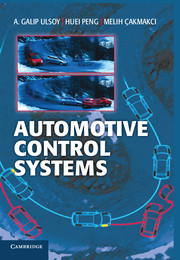Book contents
- Frontmatter
- Contents
- Preface
- Part I Introduction and Background
- Part II Powertrain Control Systems
- 6 Air–Fuel Ratio Control
- 7 Control of Spark Timing
- 8 Idle-Speed Control
- 9 Transmission Control
- 10 Control of Hybrid Vehicles
- 11 Modeling and Control of Fuel Cells for Vehicles
- Part III Vehicle Control Systems
- Part IV Intelligent Transportation Systems
- Appendices
- Index
- References
7 - Control of Spark Timing
Published online by Cambridge University Press: 05 June 2012
- Frontmatter
- Contents
- Preface
- Part I Introduction and Background
- Part II Powertrain Control Systems
- 6 Air–Fuel Ratio Control
- 7 Control of Spark Timing
- 8 Idle-Speed Control
- 9 Transmission Control
- 10 Control of Hybrid Vehicles
- 11 Modeling and Control of Fuel Cells for Vehicles
- Part III Vehicle Control Systems
- Part IV Intelligent Transportation Systems
- Appendices
- Index
- References
Summary
The focus of this chapter is the control of spark timing. As discussed in Chapter 3, the spark is ignited in advance of TDC during the compression stroke. The exact timing can influence performance, fuel economy, emissions, and knock. As discussed in Chapter 1, advancing the spark timing can improve performance and reduce fuel consumption. However, advanced spark timing also can lead to engine knocking and potential engine damage. Spark-timing control can be used, for example, in idle-speed control (see Chapter 8) with throttle control. In this chapter, we focus on the occurrence of engine knock and the control of knock by adjustment of spark timing.
Knock Control
Knock occurs when an unburned part of the air–fuel mixture within the combustion chamber explodes prematurely. This is called knocking because it generates resonating gas-pressure oscillations, which are heard as a knocking sound. Knocking can lead to serious engine damage (Heywood 1989). Historically, a low-compression ratio or conservative spark timing was used to ensure that knocking did not occur; however, this approach sacrifices performance and fuel economy. Knock control can be used when a feedback sensor becomes available, which adjusts the spark timing based on a measured variable that indicates knock. Suitable measurements include the cylinder pressure (e.g., the 5- to 15-kHz region was found to be a good knock indicator), engine-block vibrations, light emission within the combustion chamber, and ion current through the gas mixture.
- Type
- Chapter
- Information
- Automotive Control Systems , pp. 124 - 125Publisher: Cambridge University PressPrint publication year: 2012



